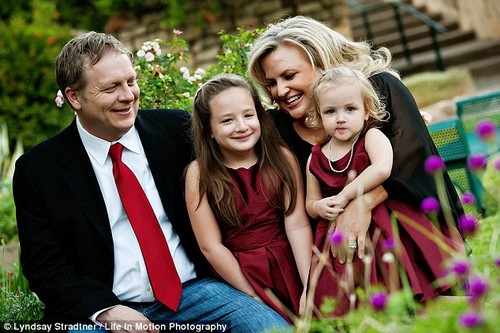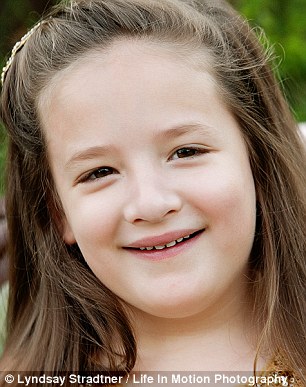Pam and Chris Andrews were devastated when they were told that their beautiful daughter Belle, now seven, was suffering from the disease which affects just 200 people in America and 500 kids worldwide, killing a majority between 10 and 20 years old.
A couple who tragically have two young daughters suffering from a devastating, rare disease nicknamed ‘childhood Alzheimer’s’ is working with research agencies and doctors on a campaign to save lives.
As it is a very rare, genetic disease, there was a one in four chances that her toddler Abby would have it too, but Pam and her husband Chris refused to believe it could happen again.
Tragically, three weeks after Belle was diagnosed, the couple from Austin, Texas were told Abby was also suffering from Niemann-Pick Type C1 (NPC1) which is fatal.
‘Every Christmas we have together we value so much. Christmas is incredibly special for us and we make the most of every single moment. We don’t know what the future is going to hold for us so we are thankful for every memory we have with our girls,’ Pam says.
Sisters Belle, seven, and Abby, three, suffer from the same rare genetic disorder that could kill them between 10 and 20 years old

The girls were diagnosed with Niemann-Pick Type C1 (NPC1), also known as ‘childhood Alzheimer’s’ which caused them to slowly regress until they can’t walk and dementia sets in

Abby and Belle with Santa on Christmas Day this year
Niemann-Pick Type C (NPC) is a disease where patients are unable to metabolize cholesterol and other lipids properly within their cells.
Excessive amounts of cholesterol then build up inside the liver and spleen, and excessive amounts of other lipids accumulate in the brain, causing its deterioration.
In most cases, neurological symptoms begin appearing between the ages of four and 10.
‘We had to deal with the thought that we would eventually – and sooner rather than later – lose half of our family to this cruel disease,’ says Pam, a 45 year-old business developer.
‘It didn’t seem fair that both our gorgeous children were going to suffer and eventually die, so Chris and I knew that we had to pick ourselves up and fight for them however we could.’
In their quest for a cure and better treatments, the couple set-up a non-profit called Firefly Fund which is working with some of the world’s leading NPC1 experts and other NPC1 families to support scientific research for NPC1 therapies.
Additionally, Firefly Fund is supporting the development of a newborn screening program LCC1 so that if a child is suffering from NPC1, they can be treated very early on, even before symptoms start.
This could mean that many more kids will live longer with fewer symptoms. For families like the Andrews, this could make such a difference.
Pam and Chris, a 45 year-old attorney, met in October 2006 and in June 2009 she found out that she was pregnant.
The couple were elated but Pam suffered from the pregnancy-related condition pre-eclampsia which causes dangerously high blood pressure for the mother.
As a result, Belle was born three and a half weeks early and she weighed just five pounds two ounces.
At her two week check, her doctor could feel the tip of her spleen, meaning it was slightly enlarged. This is an indicator of the disease but because it is so rare, the doctor had her tested for cancer.
‘We were absolutely terrified,’ says Pam. ‘When the doctor told me that she could have cancer I was, like what, how does a two-week old get cancer? It didn’t make sense.
‘The tests came back negative, thank God and nothing more was said as the spleen hadn’t got any bigger. We were so happy that she was okay so we went home to live our lives.’
But as she grew older, Belle didn’t meet her developmental milestones.
She seemed cautious sometimes when walking and her speech wasn’t developing as it should. When she was four and a half, she seemed to trip and fall every time she walked.
Worried, Pam took Belle to see a physical therapist but when PT didn’t work, she was advised to see her pediatrician in case of neurological issues.
In April 2015, her doctor could feel an enlarged spleen and visibly concerned, she advised Pam to consider genetic testing for herself, Chris and Belle.
Almost a year later in March 2016, genetics expert Dr James Gibson called with the results.
The Andrews family from Texas were devastated to learn the news after a genetic test revealed Belle had the disease and the chances of Abby also having it were high

Mother Pam, noticed that Belle (left) was slow to reach milestones and would trip when she walked. Abby (right) was diagnosed at 20 months old
Parents Pam and Chris Andrews, 45, have been working with researchers and doctors to find a cure for their daughters and others who suffer from this disease
‘We were told to go there the next morning and I was angry because I wanted to know over the phone,’ recalls Pam. ‘It was torture waiting – I don’t think me or Chris slept that night.
HOW TO SPOT NPC
Niemann-Pick Type C (NPC) is a disease where patients are unable to metabolize cholesterol and other lipids properly within their cells.
Excessive amounts of cholesterol then accumulate within the liver and spleen, and excessive amounts of other lipids accumulate in the brain.
Signs and symptoms:
- Vertical gaze palsy (the inability to move the eyes up and down)
- Enlarged liver
- Enlarged spleen
- Jaundice in young children
In most cases, neurological symptoms begin appearing between the ages of four and 10.
Generally, the later that neurological symptoms begin, the slower the progression of the disease.
NPC causes enlarged organs, lung damage, and slow and steady neurological deterioration. Patients are eventually unable to walk, talk or even breathe.
There are an estimated 500 cases diagnosed worldwide.
Doctors say there may be more, but that people confuse the disease with a learning disability or clumsiness.
There is currently no cure for NPC. Half of children die by age 10 and the majority will die before age 20.
A late onset of symptoms can lead to a longer life span, but it is extremely rare for any person with NPC to reach age 40.
Source: National Niemann-Pick Disease Foundation
‘I’d been Googling ‘enlarged spleen’ and ‘tripping and falling’ quite a lot and came up with a battery of diseases called lysosomal storage disorders – all of which are life threatening.
‘The doctor told us the next morning that Belle is suffering from Niemann-Pick Type C1 – it’s a horrific genetic disease where in time, children slowly regress until they can’t walk, eat or function properly.
‘The worst of it is that dementia will set in and eventually the child can’t recognize their own parents or siblings. Most children die by the time they are 10 although some do live longer.
‘It’s caused by both parents having a mutation in the NPC1 gene – both Chris and I are silent carriers of the disease and we never knew about it. It was just bad luck that we were both carriers and we had children together.
‘I knew that this was a death sentence for my daughter. The doctor told me to go to call the Make a Wish Foundation, go and enjoy our time together and live life the best we could.
‘I was in shock, despair, grief, I felt hopeless because I knew that one day, I would have to bury my child who wouldn’t have even lived.’
The doctor also said that Abby, who was born in June 2014, would need to be tested as there was a one in four chance that she would also have it.
When she was 20 months old, her tests came back positive for Niemann-Pick Type C1.
Belle had already started taking part in a clinical trial for a medicine called VTS-270 pioneered by Dr Elizabeth Berry-Travis in Chicago.LCC2
Every two weeks, the family was flying to Chicago where the medicine was being injected into Belle’s spine. It is the only treatment available to slow down the disease’ progress and it is showing excellent promise.
‘Hearing Abby has the disease was absolutely horrific,’ says Pam. ‘But it made us even more determined to fight as hard as we could to keep our kids alive.
‘Abby was too young to take part in the in the VTS 270 clinical trial but was able to get the therapy under compassionate use guidelines and Chris and I set up a fund raising campaign to help other families.’
As for now, apart from a slightly enlarged spleen, Abby, now three, has no symptoms. She can run, jump, sing, she does gymnastics every week and she speaks two languages – Spanish and English thanks to the sisters’ nannies.
Belle walks with an awkward gait and her speech is slushy, but she goes to school, is very sociable and she loves playing with her friends.
The girls now have their twice-monthly treatments in Austin, which is much easier and affordable for the family, but Pam and Chris are committed to finding a better treatment and ultimately the cure.
‘Having two girls with this is totally heartbreaking,’ she says. ‘And while it is a very rare disease, we are hearing of other families all the time who are suffering and being diagnosed.
‘There has to be more research. We need to find a way to slow down the disease but we also need to find a cure and I believe that it is obtainable, I really do.’
Belle is involved in a clinical trial that has slowed the progression of her symptoms though Abby is too young to participate
Pam said that learnign that both of her kids have the disease was horrifying, but made the couple even more determined to keep their kids alive
Abby has been administered drugs to slow the progression of the disease and aside from an enlarged spleen, shows no signs
Dr Elizabeth Berry-Kravis said: ‘The VTS-270 protocol is good in that it is really working in slowing down the symptoms in some patients – it’s showing such promise in a lot of children.
‘Abby is showing virtually no symptoms and we feel that is because she was started on the protocol much earlier than Belle was. Once those symptoms start, there’s no turning them back.
‘The drug can only slow it right down while we all work together towards an ultimate goal – a cure – but that’s a long way off now. That’s why this newborn screening process is going to be so important because if we can start treating the patient as early as possible, they stand a much better chance of not developing symptoms so quickly.’
Pam, Chris and leading medicine and family groups along with doctors are committed to working with NPC1 families.
Pam and Chris have started the Firefly Fund, which works hand in hand with other prominent groups, including NCAPS LCC3 and The Parseghian Fund, a group started by Cindy Parseghian who sadly lost three children to NPC1 and who has devoted her life to supporting research of this disease.
‘We actually have a lot to be thankful for this Thanksgiving,’ said Pam. ‘There is more research being done than ever before into this horrific disease and we are on the cusp of significant medical breakthroughs.
‘We are going to fight this all the way. Even though the odds are stacked against all these kids, we won’t stop until the cure is found.’



